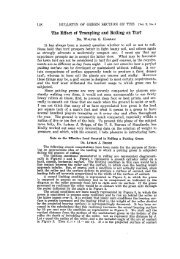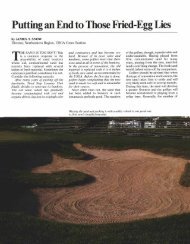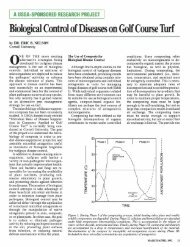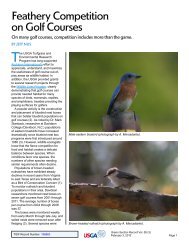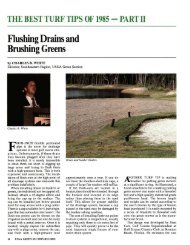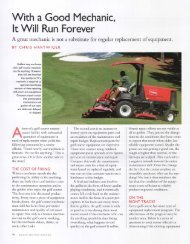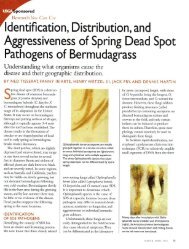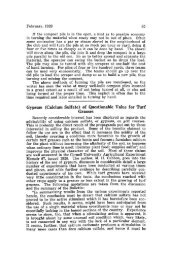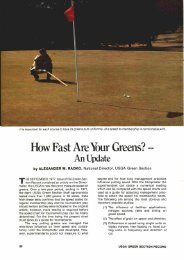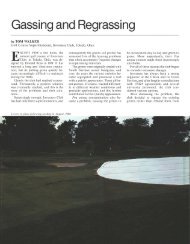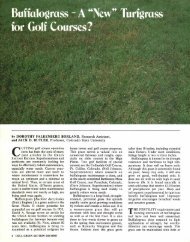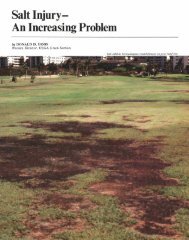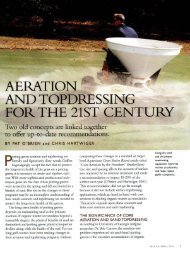Putting Green Regrassing and So Much More - USGA Green ...
Putting Green Regrassing and So Much More - USGA Green ...
Putting Green Regrassing and So Much More - USGA Green ...
Create successful ePaper yourself
Turn your PDF publications into a flip-book with our unique Google optimized e-Paper software.
number of other maladies. Such was the<br />
case at Rolling <strong>Green</strong> Golf Course, <strong>and</strong><br />
the greens failed miserably. We all know<br />
Paa annua can be pushed too far, but<br />
everyday expectations throw us in the<br />
line of fire <strong>and</strong> away from sane<br />
agrononucs.<br />
Rolling <strong>Green</strong> Golf Course was<br />
designed by William Flynn <strong>and</strong> opened<br />
in 1926. I accepted the superintendent's<br />
job in late winter of 2001. The greens<br />
had had a serious bout of anthracnose<br />
the previous summer. I came from a<br />
course with 100 percent Paa annua<br />
greens. When the search committee<br />
from Rolling <strong>Green</strong> toured my golf<br />
course during the hiring process (in<br />
October, not mid-August!), the committee<br />
saw smooth, fast Paa annua<br />
greens. I guess that sealed the deal,<br />
<strong>and</strong> I was hired.<br />
THE PROBLEM STARTS<br />
Anytime you take a new superintendent's<br />
position, it is a challenge. When<br />
anthracnose is involved on Paa annua<br />
putting greens, it is a huge challenge. In<br />
March of 2001, we noticed small yellow<br />
spots infecting our Paa annua. A sample<br />
sent to a diagnostic lab confirmed that<br />
anthracnose was the culprit. All of the<br />
appropriate fungicides you can think of<br />
were applied to control the disease. By<br />
mid-April, the anthracnose was under<br />
control, <strong>and</strong> I was thinking that we had<br />
just survived the first glitch of the<br />
season. Little did I know what was still<br />
to come.<br />
In mid-May, dime-sized spots started<br />
to form on the high <strong>and</strong> dry areas of<br />
the Paa annua greens. Heavy spring<br />
rains saw these spots progress to the low<br />
areas of the greens <strong>and</strong> coalesce into<br />
larger areas that mimicked anthracnose.<br />
A turf sample was sent to the University<br />
of Maryl<strong>and</strong>, <strong>and</strong> the diagnosis came<br />
back as bacterial wilt. Every known<br />
anthracnose fungicide was used, <strong>and</strong><br />
now we had to spray copper hydroxide<br />
to control bacterial wilt. <strong>USGA</strong> agronomists,<br />
turfgrass pathologists, <strong>and</strong> golf<br />
course superintendents all came to see<br />
the devastation.<br />
Many trees were removed to improve sunlight penetration prior to regrassing the greens. Several<br />
greens struggled during the summer because more trees should have been removed.<br />
By the end of June, turf loss on all of<br />
the greens ranged from 10 to 60 percent.<br />
A plant pathologist was brought<br />
in to make recommendations to the<br />
<strong>Green</strong> Committee. These discussions<br />
provided background information for<br />
the <strong>Green</strong> Committee to make an<br />
educated decision about the problems<br />
<strong>and</strong> potential solutions. One option was<br />
to continue spraying fungicides, overseed<br />
the greens with creeping bentgrass<br />
in August in an effort to increase creeping<br />
bentgrass populations <strong>and</strong> pray that<br />
the problems did not repeat themselves.<br />
This option was filled with a great deal<br />
of uncertainty. The second option was<br />
to close the course in August, fumigate<br />
the greens with methyl bromide, <strong>and</strong><br />
establish one of the newer creeping<br />
bentgrass varieties that are more resistant<br />
to anthracnose <strong>and</strong> tolerant of low<br />
mowing<br />
heights.<br />
THE DECISION<br />
Mter the dust settled, the committee<br />
looked at playability, lost revenue, canceled<br />
outings, <strong>and</strong> club championships.<br />
Expectations dictated that we choose<br />
the best option for the future of the<br />
club. In early July, the Board of Directors<br />
voted unanimously to close the course<br />
in early August to fumigate <strong>and</strong> regrass<br />
the greens. My head was spinning. It<br />
was my first summer <strong>and</strong> the greens<br />
were hit with every problem in the<br />
book. What did I get myself into this<br />
time? Full membership support during<br />
this time of crisis helped the situation.<br />
Unfortunately, we had only three weeks<br />
to pull the project together. This business<br />
has a way of humbling you very<br />
quickly, <strong>and</strong> I was humbed once again.<br />
Such is life when working with nature.<br />
Preparations began the following<br />
morning. We scheduled visits to other<br />
golf courses in the area that had gone<br />
through similar regrassing projects <strong>and</strong><br />
evaluated their methods <strong>and</strong> results.<br />
These trips turned out to be valuable, as<br />
there is no substitute for experience.<br />
Creeping bentgrass variety, seedbed<br />
preparation, <strong>and</strong> satisfaction with the<br />
final product were all discussed. Every<br />
course had one common recommendation:<br />
remove enough trees to improve<br />
direct sunlight penetration to the greens.<br />
Bad growing environments lead to bad<br />
greens, regardless of the grass used.<br />
The scope of the project exp<strong>and</strong>ed.<br />
Not that regrassing the greens was not<br />
enough; the list of renovation ideas kept<br />
growing since the course would be<br />
closed. <strong>Regrassing</strong> the fairways <strong>and</strong> tees,<br />
practice tee expansion, creek restoration,<br />
<strong>and</strong>, of course, tree removal were all<br />
discussed. Time was of the essence. It<br />
MARCH-APRIL 2003 9



